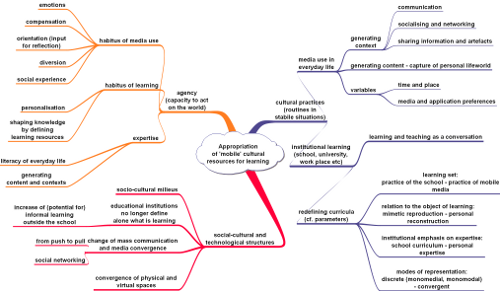
The second key issue is how learners appropriate mobile devices to set up specific learning contexts for themselves. How do they generate contexts for learning? Forming contexts with and through mobile devices outside of, as well as within existing educational sites of learning, we consider to be a key feature of appropriation. We see it related to the significant ongoing changes in terms of sociocultural practices and approaches to learning.
We define appropriation as the processes attendant to the development of personal practices with mobile devices and we consider these processes in the main to be interaction, assimilation and accommodation as well as change (Cook and Pachler, 2009; Pachler, Cook and Bachmair, 2010). Whilst clearly terminologically linked, these are not the same as the development stages that are described in Piaget's (1955) theory of development, which are sensorimotor, pre-operations, concrete operations, and formal operations. However, our work is aligned with Piaget's (1955) description of learning and perception as a constant effort to adapt to the environment in terms of assimilation and accommodation. Thus, assimilation in the context of learning means that a learner takes something unknown into her existing cognitive structures, whereas accommodation refers to the changing of cognitive structures to make sense of the environment. Furthermore, for us, the context of appropriation is emergent and not predetermined by events; centrality is placed on practice, which can be viewed as a learner's engagement with particular settings, in which context becomes 'embodied interaction' (Dourish 2004).
We see appropriation as governed by the triangular relationship between agency, practice and structures. This inter-relationship manifests itself as emerging cultural transformations and appropriation provides a lens through which to view and analyse these changes. Indeed, we suggest that media convergence, together with the fluid socio-cultural structures of milieus and their respective habitus, lead to modes of appropriation as the individualised generation of contexts for learning. The spaces thus created differentiate everyday life into individually defined contexts as well as overarch different and divergent cultural practices such as entertainment and school-based learning. We envisage that at a foreseeable future point the sociocultural developments described above will lead to a situation where there is no longer a need for a differentiation between media for learning inside and outside formal educational settings.
Our notion of appropriation also provides a conceptual frame to understand the growing gap between the literacy practices outside and inside formal educational environments. By 'literacy practices' we refer here to the cultural techniques involved in reading and producing artefacts to make sense of, and shape the sociocultural world around us. The key point is that learners are evolving practices and meanings in their embedded interactions, i.e. interactions embedded in cultural artefacts that are found outside formal learning systems. A key challenge is to support learning between and across contexts outside and inside of educational institutions. To do this as educators, we need to make use of emerging cultural transformations that mobile devices afford and bring about as well as of the resultant cultural products that enable the individualised generation of content and contexts for learning.
In short, “appropriation is a generic term governing
all processes concerning the internalization of, and externalization into
the pre-given world of cultural products across the breadth of learning
in educational institutions and in everyday life. Appropriation and the
pre-given world of cultural products work as context of development and
are indispensible for the development of human beings. Today, everyday
life works as a dominant context of development and is tied up with media
use, notably the use of mobile devices, governed by structures of mass
communication. Learning and media use, as modes of appropriation, are
cultural practices which are determined inter alia by the agency of the
user, such as her habitus of media use and of learning. Appropriation
links curricular practices with child development, which take place in
a context of social, economic, cultural and technological transformation,
with children developing their inner capacities by internalizing cultural
resources including those artefacts made available by and through, and
created with mobile devices.”
Source: Pachler, N., Cook, J. and Bachmair, B. (2010) ‘Appropriation
of mobile cultural resources for learning.’ In International Journal
of Mobile and Blended Learning 2(1), pp. 1-21.